Designers sometimes miss the point: they focus on creating a destination, rather than attempting to influence lives long-term. Instead of designing for pedestrians fixated on getting from point A to point B, we should be designing to make individuals more aware of the in-between. How do we attempt to reach the unmeasurable? Architect Louis Khan was faced with this same question “of the unmeasurable and the measurable. Nature, physical nature, is measurable. Feeling and dream has no measure, has no language, and everyone’s dream is singular.”1 But how does one proceed to design the wondrous? How does one captivate an individual from their routine? This exploration seeks the strange in the familiar by creating a research catalogue of precedents, architectural elements, and construction phases, taking them from what we assume, to what could be. We do this to see potential, and test it as a conceptual design intervention, in this case, Chicago’s Pedway system.
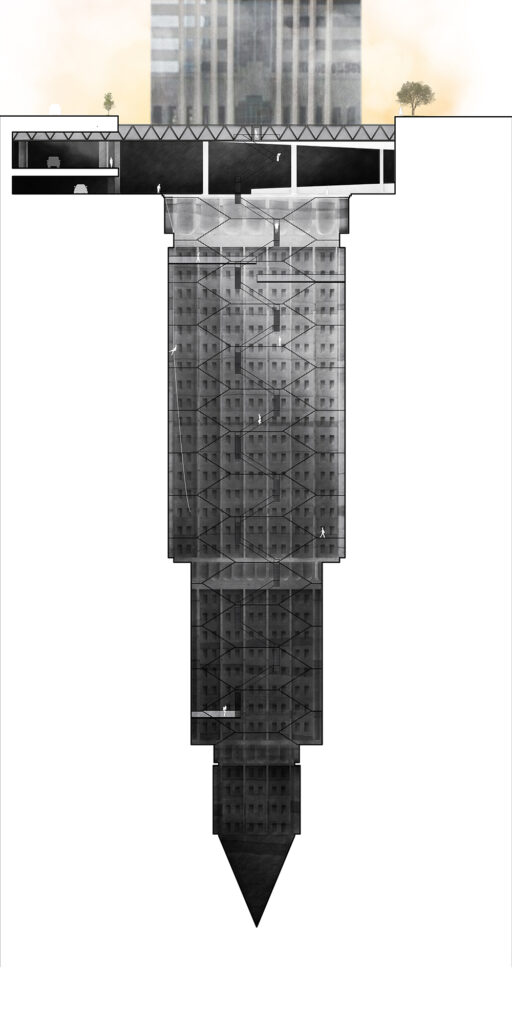
Wonder: Definition
Before diving in, we must first attempt to understand wonder, which is said to work on as a two-part narrative. It’s a delicate balancing act between two extremes: curiosity and terror. It begins with curiosity, which quickly vanishes at the discovery of a surprising phenomenon.2
This moment of surprise implies that one happens upon something strange. The approach can be a set path, such as traveling by train, or one of choice, a path we set for ourselves, both leading to a reveal. Unlike curiosity, wonder lingers. Jean-Luc Nancy said it best: “Shock punctuates; awe enchains. In shock thinking loses everything and in awe, everything returns, at once more and less than thinking had thought it to be.”3
In Greek, thambos translates roughly to “wonder or fear.” This duality reigns through multiple texts, each reiterating wonder being inherently ambivalent.4 It is the unknown in the known, the strangeness of the most familiar,5 where wonder thrives. Socrates even goes as far as to claim wonder as the origin of all philosophy.6 It deals with slippage in thought, in translation, “open not only to the fantastic and the amazing, but also to the dreadful and threatening.”7
Where Socrates embraces the unknown, Aristotle stands against wonder and unknowing; rather, he proposes a “remedy for wonder in the knowledge of cause and effect.”8 He values wonder for it catapults the participant to understand what confounds them through causal investigation. The only issue with Aristotle’s view of wonder is that “causal knowledge gradually replaces the very wonder that set it in motion.”9 Thus, it is not the final discovery of the confounding element, but the process of the discovery itself — the unknown is key.
Shedding new light on that process was Heidegger who believed wonder to be that which opens the door to a new beginning.10 By facing the contrary, to which we are most familiar, it allows wonder to transpire by revealing possibility: from what is to what could be. We often find the obvious boring, making it more powerful material to render uncanny effects.11 When the uncanny is expected, say at an art gallery, it is easy to take things for granted — lessening its impact. In uncovering the unexpected in the expected, wonder reveals itself.
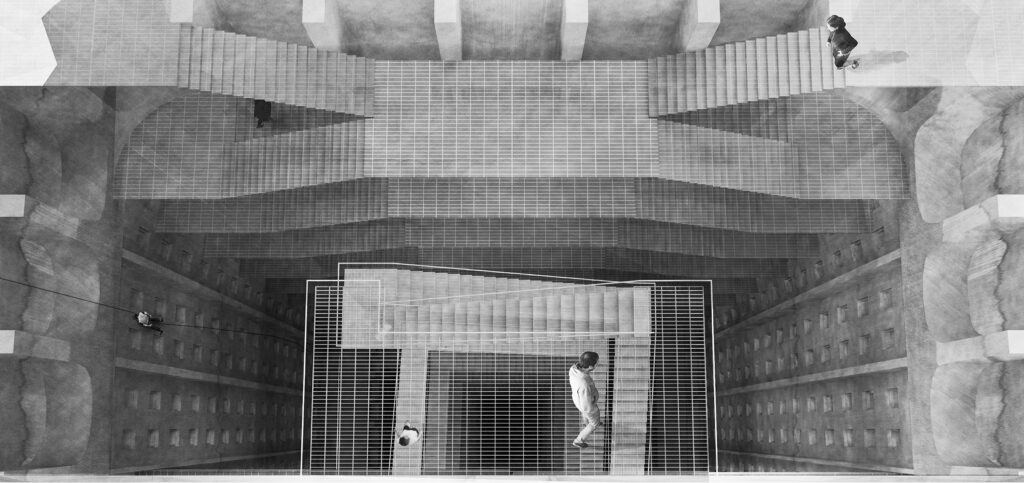
Wonder in Architecture
Within architecture, wonder generally transpires through three methods: the frame, the spectacle and the interruption. The frame presents an awe-inspiring moment at a distance, such as a captivating view through a window. The spectacle is consumed by wonder, to an extent to which it becomes the norm, such as a circus, everything is designed to capture your imagination. However, contemporary life is wrought with spectacle, dulling the senses to, each instance due to the sheer number alone. But it is the most subtle option, the interruption, which is happened-upon, and better defines the strange hidden in the familiar (Fig.1).
Interruption breaks order, allowing for rhythmic pause in much the same way as wonder similarly balances its alter egos: curiosity and terror. This amplifies the connection between the philosophical notion of wonder and the architectural operation of interruption. Double movement reigns within both phenomena: “stretching communication to its limits, toward the Other.”12 Interruption’s “line separating Other-oriented from self-oriented communication does not run between these two-modes of communication but rather within each of them.”13 This is how Interruption’s mirrored selves compositionally work together. Communication feeds our need to define everything, but leaves no room for the unknown, the unexpected, the Other. By attempting to merge these concepts through architecture this research can open the conversation to what wonder can achieve as an interruption.
Beyond definition, in tackling wonder as an interruption, one must be able to understand the possibilities of design elements. In order to create the strange out of the familiar, a certain unlearning of premature assumptions is in order: traditional architectural elements (floor, wall, ceiling, elevator, roof, window, fireplace, door, stair, balcony, ramp, corridor, facade, toilet, and escalator) were dismantled to understand their potential beyond initial preconceived considerations (Fig. 2).
In addition to the elements, as construction is an essential part of architecture, Architect Gottfried Semper’s four elements were explored: the mound (ground), the hearth (first sign of inhabitants), the frame (skeletal system), and cladding (enclosure of the built form).14 A fascinating discovery occurred in that all the elements can be traced back to the mound. An example of which can be seen in the Great Chicago Fire, where destruction was needed for reconstruction to begin again. This made Chicago the an ideal site for the study. Particularly, the downtown Pedway, an overlooked pathway under Chicago’s buildings, an in-between primarily used by locals who focus on their destination, ignoring their path along the way (Fig.3).
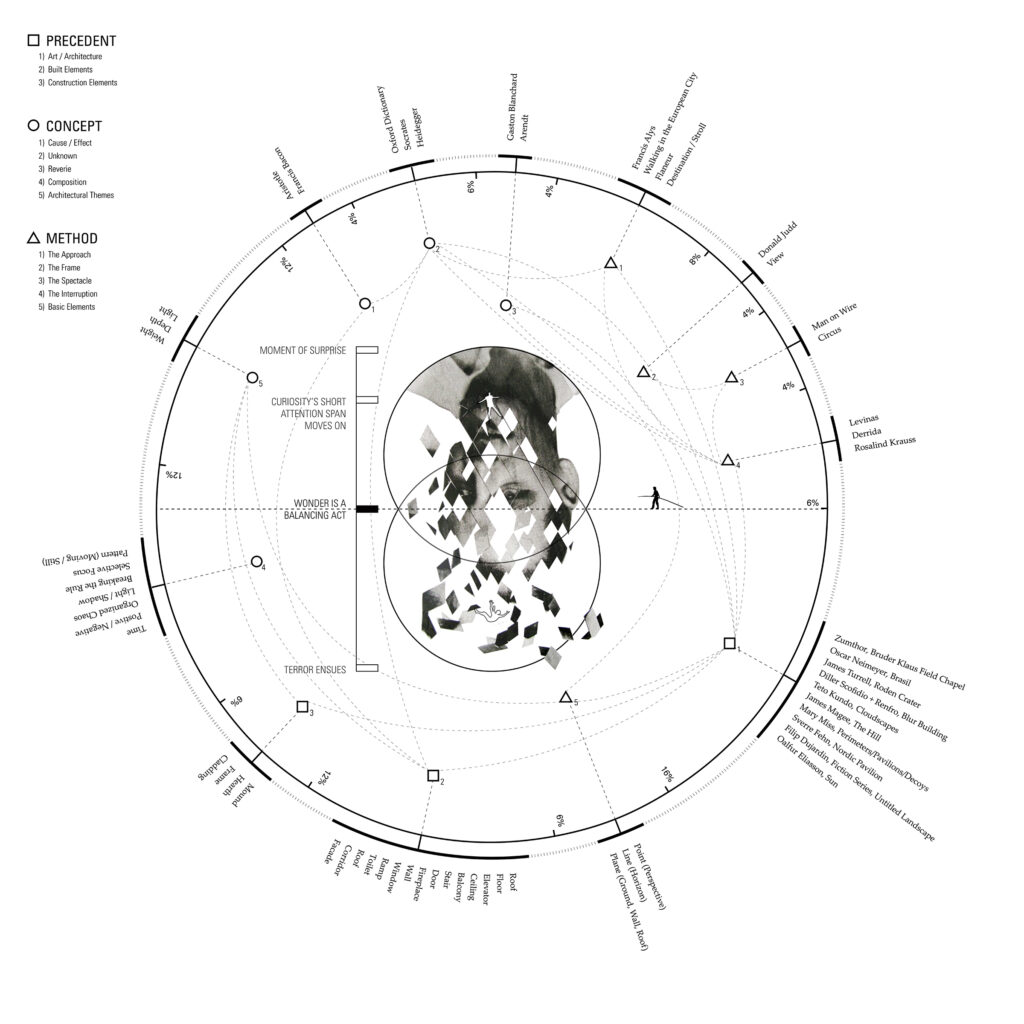
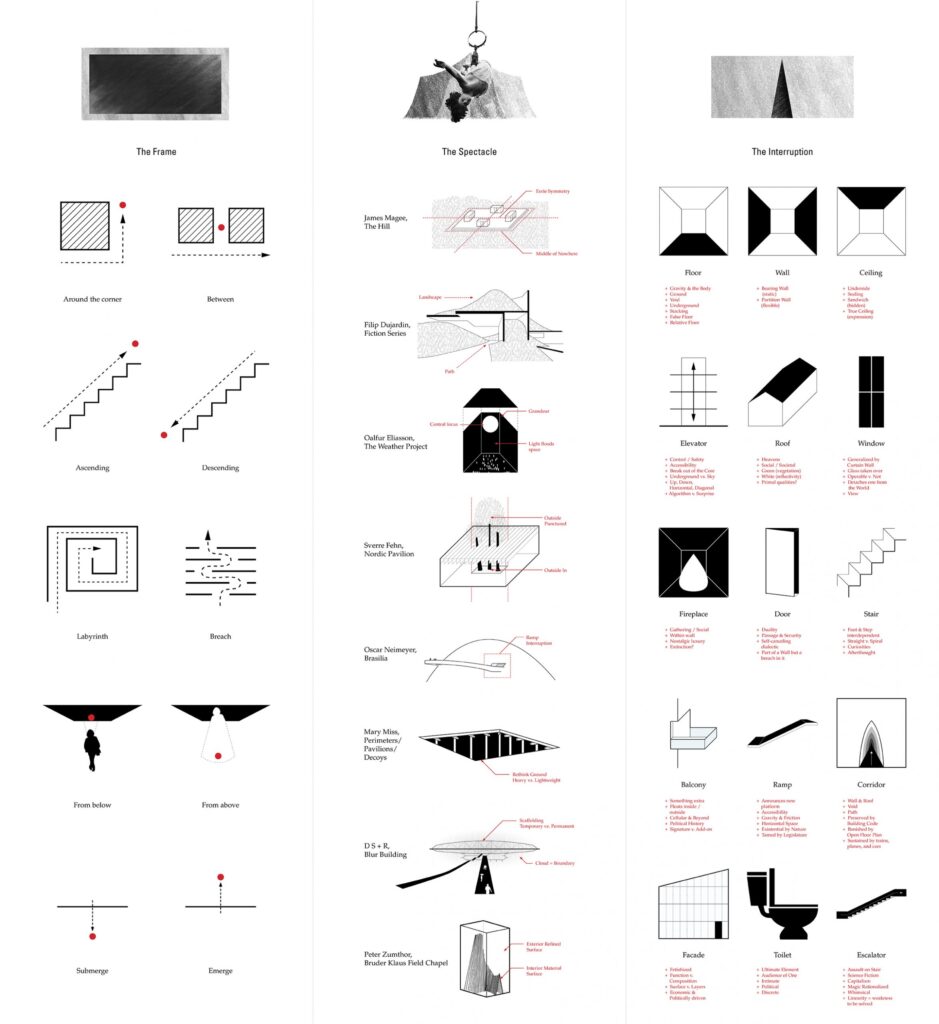
Translation: Study
This study was proposed as an interruption at the urban scale to Chicago’s future Pedway extension. Excavating space from within, while choreographing subtle circulatory details, is what entices the pedestrian to meander. For example, a detour was created as an option, not to force the attention of a pedestrian, but rather, an option to possibly explore. Choice reigns within this design. If the door detail intrigues the individual to breach the set path, they would happen upon the interruption. The floor gradation morphs from concrete to fire stair revealing a view of something unprecedented in its architectural context (Fig.4). Moreover, since wonder is fleeting and cannot be sustained, an unpredictable addition was added to the design. The underground abandoned tunnels, which the project exposes, tend to flood. In the event they do, a heated plate was designed to evaporate the excess water created at unplanned moments (Fig. 5). Lastly, an elevator was designed away from the site to get people to the ‘observation deck’ of the intervention. It is subtly highlighted as the entrance of the elevator is slightly setback from the street. It is typical in every way, except for when the observation deck button is pressed, it begins to move down diagonally until it reaches the peak of the intervention. When meandering out one looks up through a gutted inverted skyscraper made of rammed earth (Fig.6). Unlike other tower observation decks, where one looks down to to see the street, here one looks up to a boundless sky, recreating the experience in a new manner (Fig. 7).
With an undeveloped site at ground level, the intervention is supported by the edge. How it fits within its current unfinished condition, makes it easy to overlook; but when details catch one’s eye, one’s curiosity would get the best of them to approach closer (Fig.8). Exposing the extensive rammed earth detail left to discover, it reinforces the valor in wandering, never truly knowing what you will come across.
Architectural elements that hint to explore your environment further is one that offers choice to the user, whether to explore or go about their routined life. This is a secondary reinforcer in that one isn’t naturally inclined to respond to it, but rather there is a choice to, and if done so, the positive moment/experience could reinforce their behavior in the future.
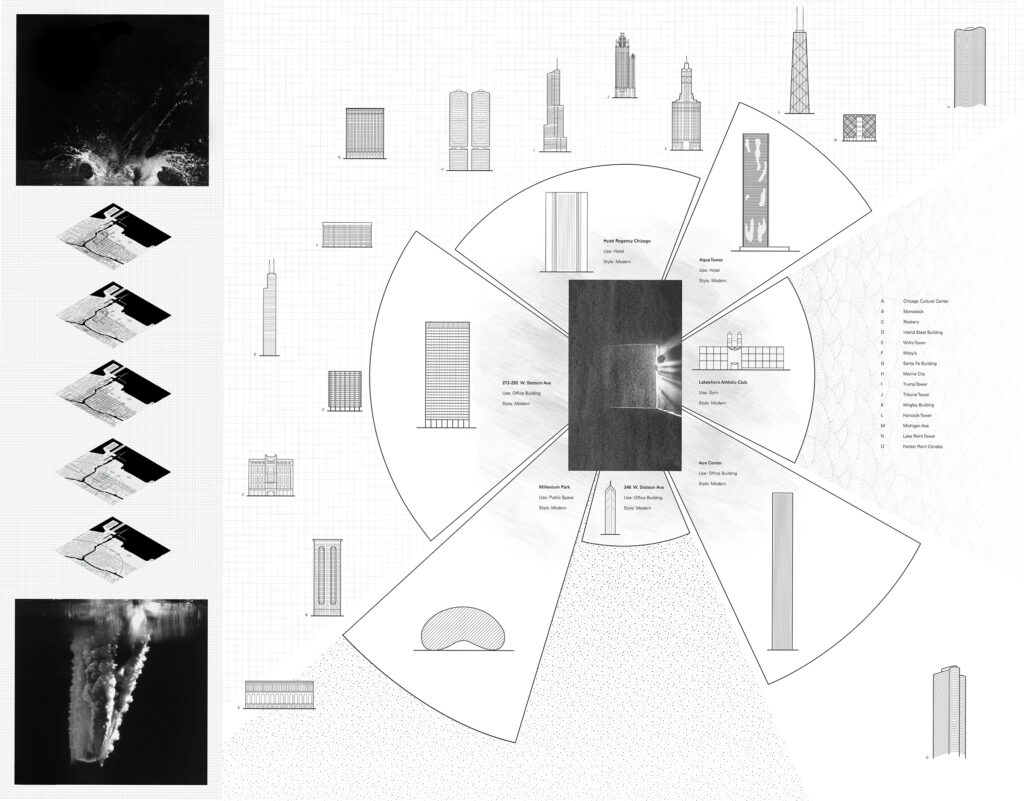
Future Application
As an academic exercise it is possible to explore such ideas, but they represent drivers for design in real-work application. The catalogue created which explores architectural elements, construction phases, and precedents of the wondrous, attempt to open the conversation to allow the reader to question their assumptions of architecture.
References
1 Kahn, Louis I., and Robert C. Twombly. Louis Kahn: Essential Texts (New York: W.W. Norton, 2003), 63.
2 Rubenstein, Mary, Strange Wonder: The Closure of Metaphysics and the Opening of Awe (New York: Columbia University Press, 2008), 7-8.
3 Ibid, 128.
4 Ibid, 9.
5 Ibid, 8.
6 Ibid, 12.
7 Ibid, 11.
8 Ibid, 12.
9 Ibid, 12.
10 Ibid, 18.
11 Ibid.
12 Pinchevski, Amit, By Way of Interruption: Levinas and the Ethics of Communication, (Pittsburgh, Pa.: Duquesne University Press, 2005), 13.
13 Ibid, 17.
14 Solomon, Nancy B. Architecture: Celebrating the Past, Designing the Future (New York: Visual Reference Publications, 2008), 129.

